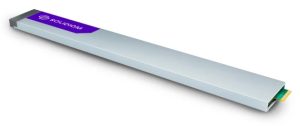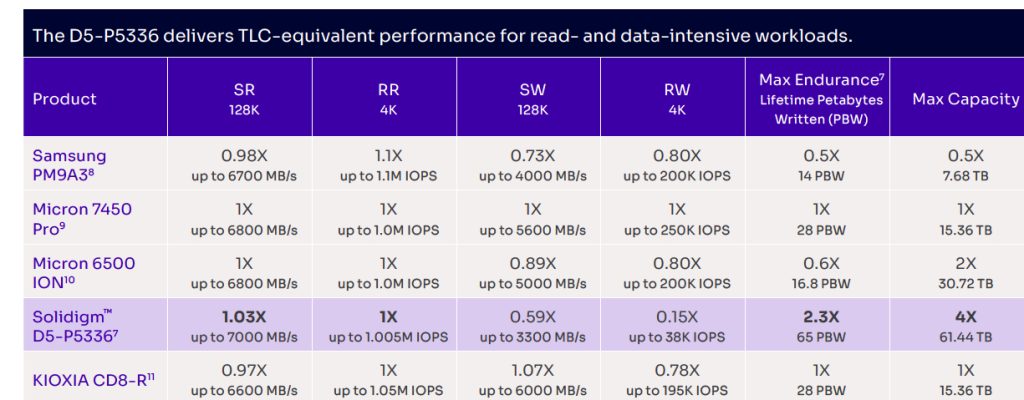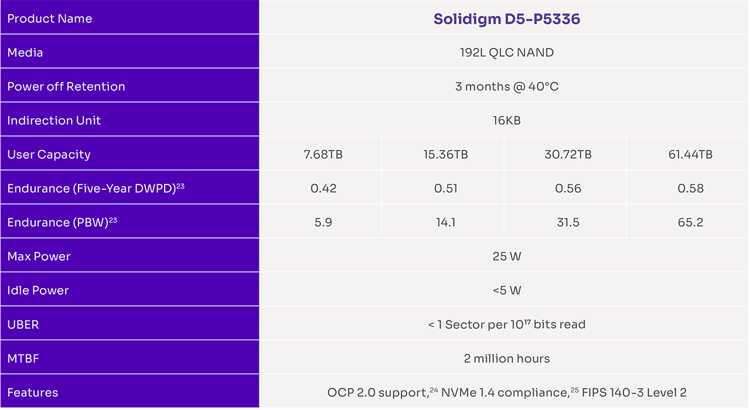61.44TB: WW Record Capacity for PCIe SDD
On Solidigm D5-P5336
This is a Press Release edited by StorageNewsletter.com on July 24, 2023 at 2:02 pmSolidigm announced the D5-P5336 another QLC SSD Series for the data center.
Offered in capacities from 7.68 to 61.44TB, the D5-P5336 makes it possible to store up to 6x more data in the same space compared to an all HDD array.(1)
“Modern workloads like AI and capabilities like 5G are rapidly reshaping the storage landscape,” said Greg Matson, VP, strategic planning and marketing. “Businesses need storage in more places that is inexpensive, able to store massive data sets efficiently and access the data at speed. The D5-P5336 delivers on all three -,value, density and performance. With QLC, the economics are compelling – imagine storing 6x more data than HDDs and 2x more data than TLC SSDs, all in the same space at TLC speed.”
Built to handle massive amounts of data from the core to the edge, the read performance of the D5-P5336 exceeds some of the latest cost-optimized TLC SSDs on the market today. (2) AI, ML, content delivery networks, scale-out NAS, and object storage are all read-intensive workloads that continue to drive enormous volumes of data, regardless of where they reside.
Massive scalability and improved TCO across a range of configurations
With its high capacity enabling smaller storage footprints, D5-P5336 enables a lower TCO infrastructure than all-TLC arrays, SAS HDD arrays, or hybrid arrays. Consider the following, based on a 100PB object storage solution deployment:
“For years there has been debate about endurance and reliability of SSDs, QLC in particular, but Solidigm might have ended that debate with the D5-P5336,” noted Avery Pham, VP operations, Vast Data Ltd. “Any number of applications will see notable benefits from these drives from AI and machine learning to object storage.”
“Today, it is clear that the primary constraint for edge workloads is the limitation of bandwidth rather than latency,” said Doug Emby, VP sales and business development, Cheetah RAID Storage. “Solidigm’s D5-P5336 QLC SSDs offer an impressive combination of capacity, performance, and reliability as a solution to overcome this challenge. The seamless integration of these Solidigm QLC SSDs with Cheetah’s high-performance servers makes them highly suitable for the efficient deployment of edge solutions.”
The D5-P5336 is shipping in E1.L form factor with up to 30.72TB, with subsequent availability extending to 61.44TB in both U.2 and E1.L later this year. In the 1H24, the company will be shipping E3.S form factor with up to 30.72TB.
Performance :
- Random read (100% Span) : 1,005,000 IO/s (4K, QD256)
- Random write (100% Span) : 29.900 IO/s (16K, QD256)
- Power – Active : 25W
- Power – Idle : 5W
- Latency – Random read (typ.) : 15μs (16K blocks)
- Latency – Random write (typ.) : 31μs (16K blocks)
- Latency – Sequential read (typ.) : 110μs (4K blocks)
- Latency – Sequential write (typ.) : 15μs (16K blocks)
Resource:
Solidigm D5-P5336 product brief
(1) All-HDD capacity based on 12×3.5” front load bays x20TB = 240TB. HDD capacity does not factor in any over-provisioning required to meet storage performance needs. All-QLC capacity based on 24x U.2 front load bays x 61.44TB D5-P5336 = 1474TB. Max 2U U.2 based on HPE Proliant DL385 Gen 11 configuration. Max 2U 3.5” HDD bays based on Supermicro 2U SuperServer design.
(2) Up to 34% higher throughput than entry TLC SSDs and 20% higher than mainstream TLC SSDs for CDN workload. Comparing 15.36TB Solidigm D5-P5336 with read BW of 7.5GB/s to15.36TB Kioxia CD8-R with 5.6 GB/s as entry TLC SSD and to 15.36TB Micron 7450 with 6.2GB/s as mainstream TLC SSD. Workload based on representative customer profile. Test Configuration: Supermicro SYS-120U-TNR, Intel Xeon Gold 6354. Number of CPUs: 2, Cores per CPU: 18 (total 36), DRAM: DDR4 – 64GB, OS: Ubuntu 20.04.5 LTS Linux 5.15.0-67-generic. FIO 3.16.
Comments
Among our databases, one is dedicated to SSDs only with all the models - a total of 1,802 - announced since 1991 with their main specs, the first unit being the SF-1200 SSD Processors from SandForce in 1991.
Indeed, the Solidigm D5-P5336 is up to now the WW most capacitive PCIe SSD at 61.44TB.
Nevertheless the highest one is the ExaDrive NL/DC from Nimbus Data, revealed in 2020 at 100TB, with 6Gb SAS or SATA interface, but in 3.5-inch form factor about never used.
Four PCIe models - but one only in demo and never produced - are reaching a little less capacity than than the D5-P5336, 64TB:
| Year announced | Manufacturer | Model | Max. capacity (GB) | Interface | Comment |
| 2018 | NGD Systems | Newport | 64,000 | PCIe Gen 3x4, NVMe 1.3 | |
| 2021 | ScaleFlux | CDS 3000 | 64,000 | PCIe Gen4 NVMe | TLC, QLC |
| 2021 | ScaleFlux | NSD 3000 | 64,000 | PCIe Gen4 NVMe | TLC, QLC |
| 2016 | Seagate |
64,000 | NVMe | Demo at FMS 2017 |
or all these announcements, no prices were released. For just one reason, they are very expansive.
For HDDs, the record capacity is now 22TB in 3.5-inch form factor, 6Gb SATA and 7,200rpm, from Seagate and Western Digital, but they are expanding very slowly compared to SSDs as they are reaching a limit in areal density. All manufacturers have stopped to release 2.5-inch HDDs and will progressively stop to make them, the last announcement being the MG04 by WD at 2TB in March 2018.
The capacity of SSDs depends directly from the number of layers contained in their chips going from 32, 48, 64, 96, 112, 128, 144 and 176, and 218 to come from WD and Kioxia, as well as 232 from Micron and YMTC, and even 238 from SK hynix.
SSDs have already eaten slowly the 2.5-inch HDD market and will limit HDDs to only high-capacity drives because of their lower price/GB, but the trend is clearly in favor of SSDs.


















 Subscribe to our free daily newsletter
Subscribe to our free daily newsletter

